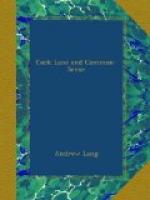‘Shadow’ or Magic of the Dene Hareskins: its four categories. These are characteristic of all Savage Spiritualism. The subject somewhat neglected by Anthropologists. Uniformity of phenomena. Mr. Tylor’s theory of the origin of ‘Animism’. Question whether there are any phenomena not explained by Mr. Tylor’s theory. Examples of uniformity. The savage hypnotic trance. Hareskin examples. Cases from British Guiana. Australian rapping spirits. Maori oracles. A Maori ‘seance’. The North American Indian Magic Lodge. Modern and old Jesuit descriptions. Movements of the Lodge. Insensibility of Red Indian Medium to fire. Similar case of D. D. Home. Flying table in Thibet. Other instances. Montezuma’s ‘astral body’. Miracles. Question of Diffusion by borrowing, or of independent evolution.
Philosophers among the Dene Hareskins in the extreme north of America recognise four classes of ‘Shadow’ or magic. Their categories apply sufficiently closely to all savage sorcery (excluding sympathetic magic), as far as it has been observed. We have, among the Hareskins:—
1. Beneficent magic, used for the healing of the sick.
2. Malevolent magic: the black art of witchcraft
3. Conjuring, or the working of merely sportive miracles.
4. Magic for ascertaining the truth about the future or the distant present—clairvoyance. This is called ’The Young Man Bound and Bounding,’ from the widely-spread habit of tying-up the limbs of the medium, and from his customary convulsions.
To all of these forms of magic, or spiritualism, the presence and aid of ‘spirits’ is believed to be necessary, with, perhaps, the exception of the sportive or conjuring class. A spirit helps to cure and helps to kill. The free spirit of the clairvoyant in bondage meets other spirits in its wanderings. Anthropologists, taking it for granted that ‘spirits’ are a mere ’animistic hypothesis’—their appearances being counterfeited by imposture— have paid little attention to the practical magic of savages, as far as it is not merely sympathetic, and based on the doctrine that ‘like cures like’.
Thus Mr. Sproat, in his excellent work, Scenes and Studies of Savage Life, frankly admits that in Vancouver Island the trickery and hocus-pocus of Aht sorcery were so repugnant to him that he could not occupy himself with the topic. Some other travellers have been more inquisitive; unlettered sojourners among the wilder peoples have shared their superstitions, and consulted their oracles, while one or two of the old Jesuit missionaries were close and puzzled observers of their ‘mediumship’.
Thus enough is known to show that savage spiritualism wonderfully resembles, even in minute details, that of modern mediums and seances, while both have the most striking parallels in the old classical thaumaturgy.




